Everyone has a first time doing something. The first time on a high-speed train, the first time on a sleeper bus, or the first time on a plane for example! You will surely feel confused because you don’t know what to prepare, what to do, and how to do it right. That’s why in this article, Cuồng will share 10 things you need to know for first-time airplane travelers. Make sure to remember these 10 things to help you with every detail from A to Z for a smooth takeoff for first-time domestic air travelers. And the 10 things you need to know for your first flight are:
1. Airline ticket
2. Time to go to the airport
3. Prepare personal documents
4. Instructions for airport procedures
5. Regulations on luggage when flying
6. Choosing a seat on the plane
7. Through security and boarding
8. Rules on the plane
9. Flying with a baby
10. Dealing with ear discomfort
11. Arriving at the airport and collecting checked baggage
So what are you waiting for? Let’s start learning the first thing to do when flying for the first time!
1. Airline ticket
As an airline ticket office employee, every day you sell countless tickets from north to south, from domestic to international. Just hearing the question “how do I get my airline ticket?” immediately reveals that this customer has never flown before. If that’s the case, let me tell you that nowadays all airlines no longer issue paper airline tickets when you book a flight, but only send a code consisting of a series of letters or numbers depending on the airline. Issuing an electronic code instead of a paper airline ticket will be extremely convenient. Because when you go to the airport with nervousness for your first flight, it’s common to forget a few things, including the airline ticket.
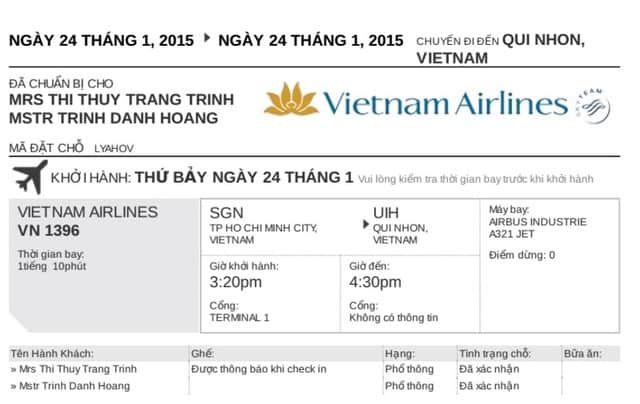
Therefore, with this electronic code, you can save it in your email or text message on your phone. Even if you forget to bring your phone to the airport, you can borrow someone else’s phone to call the airline ticket office to have the code read back to you so you can still fly as planned.
However, for first-time flyers who are worried and don’t know how to check the status of their ticket, Cuồng will guide you. After purchasing your airline ticket and having the code in hand, whether you bought it directly from the airline or through a ticket office, you should still call the airline to double-check. You can call the airline’s hotline to speak with a hotline operator. Then provide the ticket code, flight itinerary, flight time, and the list in the ticket code. The airline staff will accurately check if this ticket is valid, if it has been paid for, and even the exact flight time if there are any changes in the schedule.
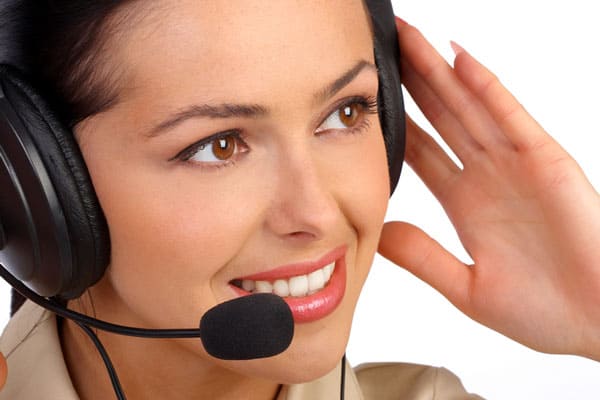
Here are the hotline numbers of some major airlines that you can refer to:
⦁ Vietjet Air hotline: 19001886 – usually Vietjet Air hotline is always busy, so you need to be patient and call multiple times to reach a hotline operator.
⦁ Jetstar Pacific hotline: 19001550 – Jetstar Pacific airline hotline seems to provide better service. With more staff, you can reach a hotline operator after a few rings. The hotline operators of Jetstar Pacific are very enthusiastic and even provide free support if there are any errors on your ticket such as a misspelled name or incorrect gender.
⦁ Vietnam Airlines hotline: 1900 1100 – the hotline operators of VN Air are known for their quick and enthusiastic support.
⦁ Bamboo Airways hotline: 1900 1166 – as this is a new airline, there is no need to mention the enthusiasm of the hotline operators. They are very quick and enthusiastic.
2. Airport Arrival Time
For first-time flyers, it can be nerve-wracking. Some arrive hours early out of fear of missing their flight, while others are more casual, thinking it’s like taking a train or bus, arriving just 5-10 minutes before. However, knowing the airport arrival time for flight check-in is crucial. It can directly impact your flight. All airlines have strict check-in counter opening and closing times, boarding times, and gate closure times. Therefore, you need to know this essential information to ensure your flight is on time.
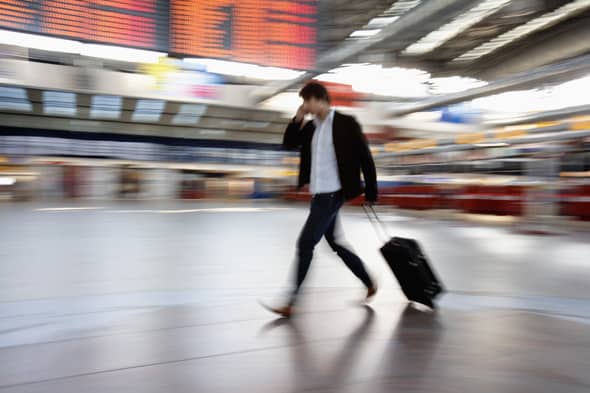
⦁ Opening/closing time of domestic airlines’ check-in counters
Vietnam Airlines, VietJet Air, and Jetstar Pacific specify the opening/closing times of check-in counters at the airport as follows:
For domestic flights
– Opening time: 2 hours before the scheduled departure time.
– Closing time (end of passenger acceptance): 40 minutes before the scheduled departure time.
Therefore, Cuong advises you to be at the airport at the latest 90 minutes before your flight if you are traveling on a regular day. But if you are flying on weekends, holidays, or during the summer, it is recommended to be there at least 120 minutes in advance. Because on these days, the airport is crowded with people.
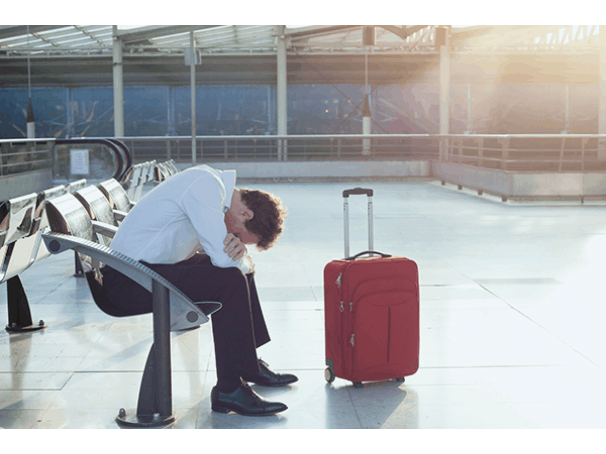
⦁ For international flights departing from Vietnam
– Counter opening time: 3 hours before the scheduled departure time.
– Counter closing time (end of passenger acceptance): 50 minutes before the scheduled departure time.
Note: The counter opening/closing time for procedures may vary depending on the airport or specific flights and if there are changes, passengers will be notified in advance.
– You need to be at the boarding gate (after completing check-in and passing security) 25 minutes before departure time.
– The boarding gate will close 15 minutes before departure time. Once the gate is closed, you will not be allowed to board the flight.
If you are not at the check-in counter on time, you will have to pay a late fee or buy a new flight ticket if you still want to fly.
First-time flyers should note that airlines usually send notifications if there are significant changes to your flight time. However, if the change is only 10-15 minutes, the airline may not notify you. Therefore, before your flight, you should call the airline to update your accurate flight time and make sure it fits your schedule!
3. Travel Documents
This is the most confusing issue for first-time flyers. Usually, air travel has stricter regulations regarding travel documents compared to traveling by train or car. The requirements for travel documents on domestic and international flights will also differ, so you need to pay attention to this.
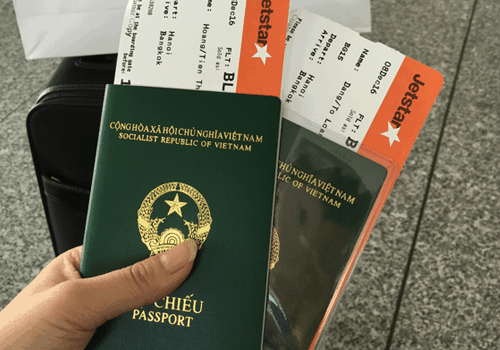
⦁ Domestic flights
⦁ Passengers aged 14 and above must present:
⦁ Passport
⦁ ID card/ Citizen identification card;
⦁ National Assembly delegate card; Party member card; Press card;
⦁ Driver’s license for car, motorcycle;
⦁ Aviation security control card; identification card of Vietnamese airlines;
⦁ Passengers under 14 years old must present:
⦁ Passport
⦁ Original birth certificate or certified copy. In case the child is under 01 month old and does not have a birth certificate, a birth confirmation document with the parents’ names as required. Please note, some first-time flyers are often afraid of losing documents or have heard about needing a copy, so they bring a photocopy of the birth certificate and get it notarized. But the airline will not accept this document, so make sure to have the certified copy of the birth certificate that the local authorities send along with the original.
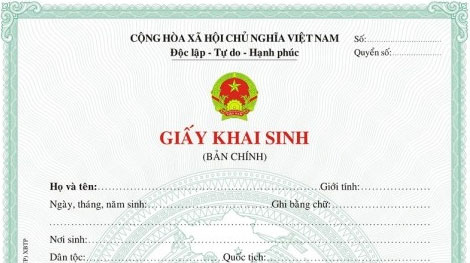
⦁ Confirmation letter from the social organization for children being fostered by the social organization.
⦁ International flights
⦁ When going through airport procedures on international flights, you must present your passport or other valid entry documents as required by the destination country. Normally, the passport must be valid for at least 6 months from the date of entry into that country.
⦁ To be allowed entry into another country, you need to apply for a visa to that country before departure. However, each country has different visa exemption policies. Before flying, make sure you have checked the latest information on visa requirements or entry requirements of the country the passenger will be arriving in.
⦁ If you have connecting flights and have a stopover in a third country, you must have the necessary documents for entry at the stopover point, the connecting point in your itinerary. Additionally, you may be required to retrieve your checked baggage (if any) and check-in for your connecting flight.
4. Airport procedures
Because it’s your first time flying, many of you may be worried about not knowing how to go through the procedures. That’s why many passengers on early morning flights have to ask ticketing staff to guide them to the airport early to help with the procedures. Enthusiastic staff will be fine, but difficult ones may think you are deliberately trying to trick them. The airport procedures are extremely simple. After checking the flight time, ticket code, and preparing your luggage and documents, you can choose one of the following 3 ways to go through airport procedures:
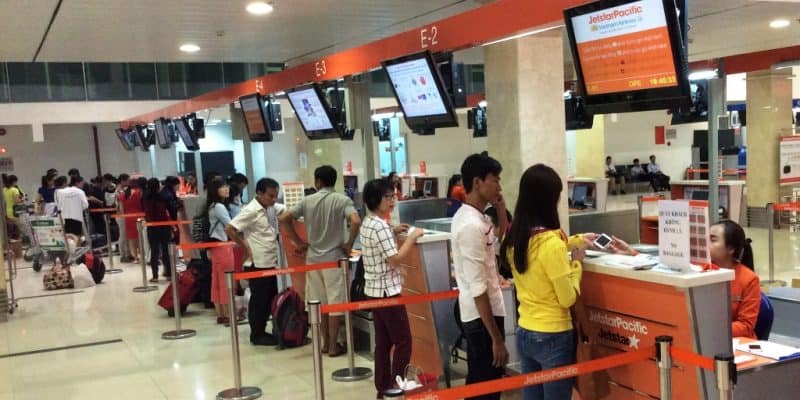
⦁ Check-in at the airport counter. This is the most traditional and simplest way for first-time flyers. You just need to go to the airport, head to the check-in counter of the airline you booked your ticket with. Provide the code and documents as instructed by the staff at the counter. Then weigh your luggage and wait for the staff to return your documents and ticket. However, this airport check-in process can be a bit time-consuming, so you may have to wait in long lines before it’s your turn.
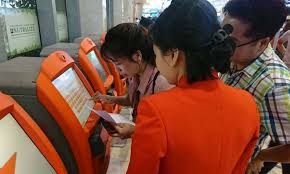
⦁ The second airport procedure seems to be faster, which is doing the procedure at a kiosk. In order to reduce the workload for airport counter staff, some airlines have set up automatic kiosks for airport procedures. What you need to do is enter the ticket code on the touch screen of the kiosk and follow the instructions until the machine prints out your boarding pass. It may sound complicated, but all the instructions on the machine are in Vietnamese and there are always airline staff around to assist you, so you can rest assured. However, the airport procedure through a kiosk only applies to codes without infants under 2 years old and without checked baggage. Because if you have checked baggage, you still have to go to the counter to check in your luggage.
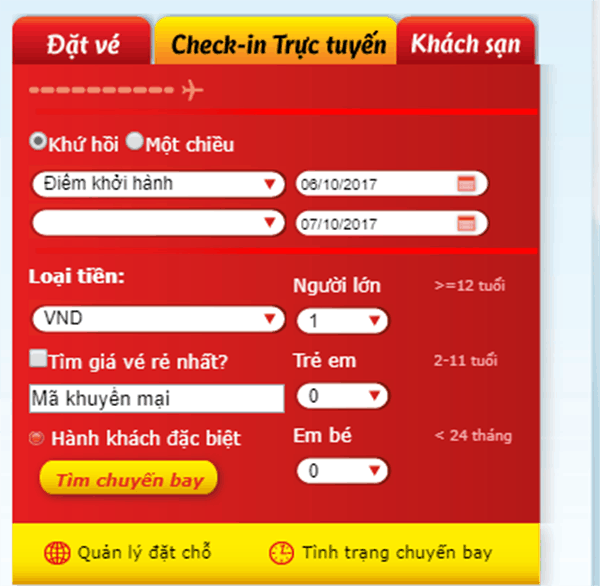
⦁ Another simple and quick way to go through airport procedures is to check in online. This means that 24 hours before the flight, the airline has started opening counters for online check-in. What you need to do is log in to the airline’s website, go to the web check-in section or online check-in, enter the code and follow the instructions, then choose to receive the ticket in a PDF file or via text message. If you are flying for the first time and don’t know how to do it, you can ask the staff at the agency to do it for you and they will send the ticket to your phone. This way, you can confidently hold your ticket and go straight to the security counter without having to push and wait tiredly. However, this online check-in method also has its drawbacks, as it does not apply to babies under 2 years old and does not include checked baggage. Currently, this online check-in method is only available at Tan Son Nhat Airport and Noi Bai Airport.
5. Regulations on baggage
For first-time flyers, all regulations are very important and need to be carefully understood. And of course, among them are regulations on baggage. What needs to be checked, what needs to be carried on board. What can be brought and what is prohibited,…. It may sound complicated, but it is indeed quite complex. However, knowing and complying with the regulations will make your flight easy and convenient. Now let’s find out together!
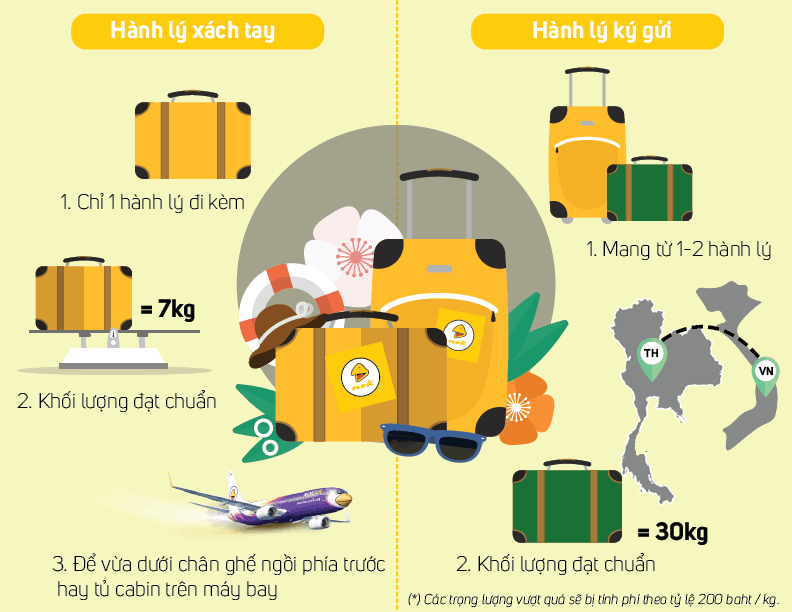
⦁ Regulations on carry-on baggage
Usually when buying a plane ticket, regardless of the airline or ticket class, you will be allowed at least 7kg of carry-on baggage. With VN Airline and Bamboo Airways, you will be given an additional 20kg of checked baggage. Although it’s said to be given, it’s likely that the cost has already been included in the ticket price as the airfares of these two airlines are relatively high.
Each passenger (excluding infants) is allowed to carry 01 main piece of carry-on baggage and 01 small personal item with a total weight not exceeding 07kg.
• 01 main piece of carry-on baggage with maximum dimensions of 56cm x 36cm x 23cm.
• 01 small personal bag (which can be one of the following):
+ 01 women’s handbag or book, magazine, camera, baby food bag, shopping bag at the airport… with dimensions not exceeding 30cm x 20cm x 10cm.
+ 01 coat bag with maximum dimensions when opened not exceeding 114cm x 60cm x 11cm.
+ 01 laptop bag with maximum dimensions of 40cm x 30cm x 10cm.
a) Liquids must be stored in containers with a volume not exceeding 100ml;
b) All liquid containers with a maximum volume of 100ml each can be easily separated into a transparent resealable plastic bag with a capacity of 1 liter.
c) The plastic bag may need to be opened separately at the security checkpoint. You may be required to discard liquids if they do not meet the above requirements.
Important notes:
+ If carry-on baggage does not comply with regulations, you may have to pay a fee to check the baggage or your baggage may be refused for transport.
+ Baggage check-in fees will be higher at the check-in counter and at the departure gate. Make sure to purchase baggage in advance to save more.
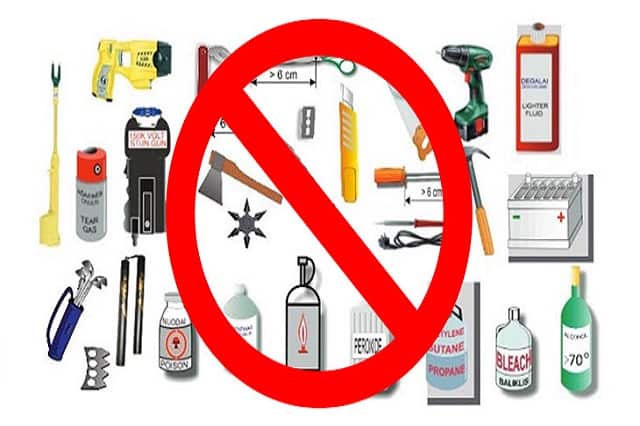
⦁ Regulations on checked baggage
Depending on the usage needs, checked baggage is divided into packages of 15kg, 20kg, 30kg, and 40kg. Each person is not allowed to purchase more than 60kg of checked baggage.
The size of checked baggage must not exceed: 119cm x 119cm x 81cm
If you purchase checked baggage when booking your ticket, the price will be cheaper. If you wait until you get to the airport to buy it, the price will usually double.
The following items are not accepted as checked baggage or for transport in baggage: The airline has the right to refuse to transport baggage or items in baggage as follows:
a. Items not properly packaged in suitcases or other suitable containers to ensure safe transportation with normal care and handling.
b. Items that may pose a hazard to the aircraft, people, or property on the aircraft.
c. Items prohibited by the laws, regulations, or orders of any state or country where the flight departs, arrives, or passes through.
d. Items deemed unsuitable for transport by the airline due to their weight, shape, size, or nature.
e. Fragile or perishable items;
f. Live or dead animals.
g. Human remains or animals.
h. Live or frozen seafood or unpackaged meat not packed in styrofoam containers according to the proper standards.
i. Guns and ammunition.
j. Explosives, flammable gases, corrosive substances, flammable substances, oxidizing substances, etc.
There are many regulations regarding baggage when flying, but each airline will have its own regulations, which will be discussed in a later article. This article will only introduce general information to help first-time flyers remember.
6. Selecting a seat on the plane
If your flight ticket is in the economy or economy saver class, the seat arrangement on the plane will be randomly assigned unless you choose the additional service of selecting a seat. Selecting a seat on the plane helps you choose a seat in a row with more legroom or closer to the aisle. However, you will have to pay an additional fee ranging from a few hundred to several million.
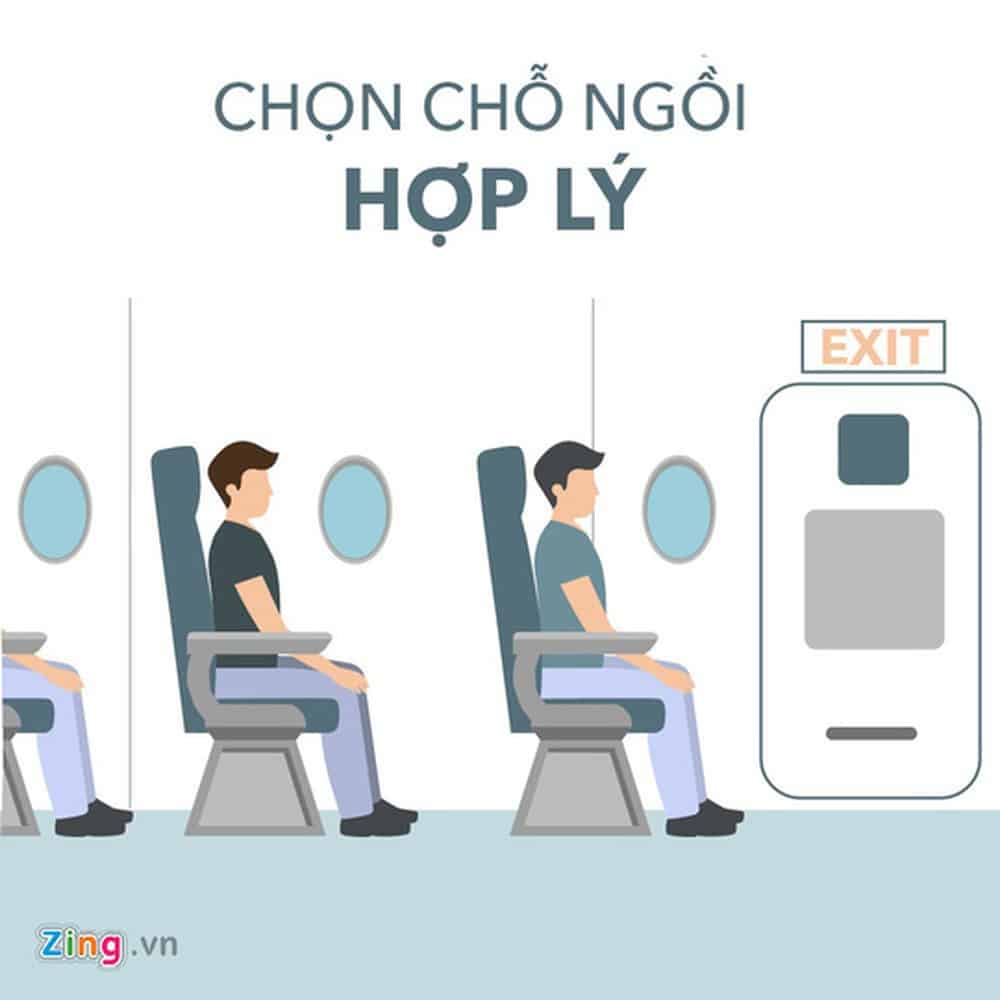
If you are flying for the first time, you may not know and may easily listen to the advice of the staff to choose additional services. Consider that if your flight is only a few minutes to 2 hours, Cuong thinks this fee is not really necessary. Instead of spending money on this seat, save it to buy some souvenirs or enjoy some new services at your upcoming destination.
7. Through security and boarding the plane
When you hear about going through security, if you are flying for the first time, you may be very nervous. Looking at the serious-looking staff at the counter, you may feel no emotions. However, don’t worry too much. Just follow the rules. When you reach the security counter, you need to line up and wait your turn without pushing.
When it’s your turn, you just need to present your ID along with your boarding pass to the security staff for inspection. After the security staff checks your documents, you will move to the conveyor belt. Here, you just need to place your carry-on luggage on the belt. There are small baskets there. You will take a basket and remove your shoes, belts, watches, jackets, hats, etc., for them to go through the conveyor belt for security inspection. Then you walk through the scanner and retrieve your belongings.
And of course, after that, you just need to move to the boarding gate printed on your ticket to wait to board the plane. It may sound complicated, but it’s actually very easy, right!? In the waiting area, there are electronic boards so you can regularly check to ensure you board your flight on time!
8. Regulations on the plane
Some notes on the airplane
Behaviors such as: disturbing order on the plane; verbal abuse or threats; physical attacks; threats; being drunk or causing disorder; excessive alcohol consumption; refusing to follow crew instructions; endangering the safety of the plane… are not allowed on the plane. If these behaviors occur, the plane may have to make an emergency landing and passengers may be forcibly removed from the plane, denied transportation, fined, or prosecuted.
Safety instructions
On flights, the crew will instruct on how to use safety devices and safety regulations before takeoff. Passengers need to follow these instructions to ensure safety throughout the flight.
Even for passengers who frequently fly, as different planes have different safety instructions and emergency equipment, passengers need to pay attention to these instructions.
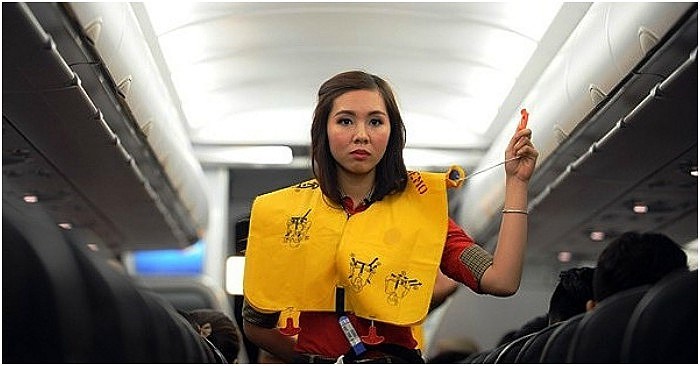
No Smoking
No smoking is a common regulation on airplanes. Airlines in Vietnam such as Vietnam Airlines, Vietjet Air all operate smoke-free flights. Therefore, please comply and remind other passengers if they intend to smoke.
Seating
Seats on airplanes are usually printed on the ticket. Please find your correct seat number or ask for assistance from the flight attendant if needed.
How to Use Seat Belt
When the seat belt sign is on, press the two ends of the seat belt firmly together, one end to tighten and the other end to loosen. For children, flight attendants will provide a separate seat belt. To release the seat belt, simply lift the buckle. If you encounter any difficulties, the flight attendants of Cathay Pacific, Austrian Airlines are always willing to help.
Use of Electronic Devices
You should limit the use of electronic devices such as mobile phones, handheld transmitters. Typically, flight attendants will remind passengers before takeoff.
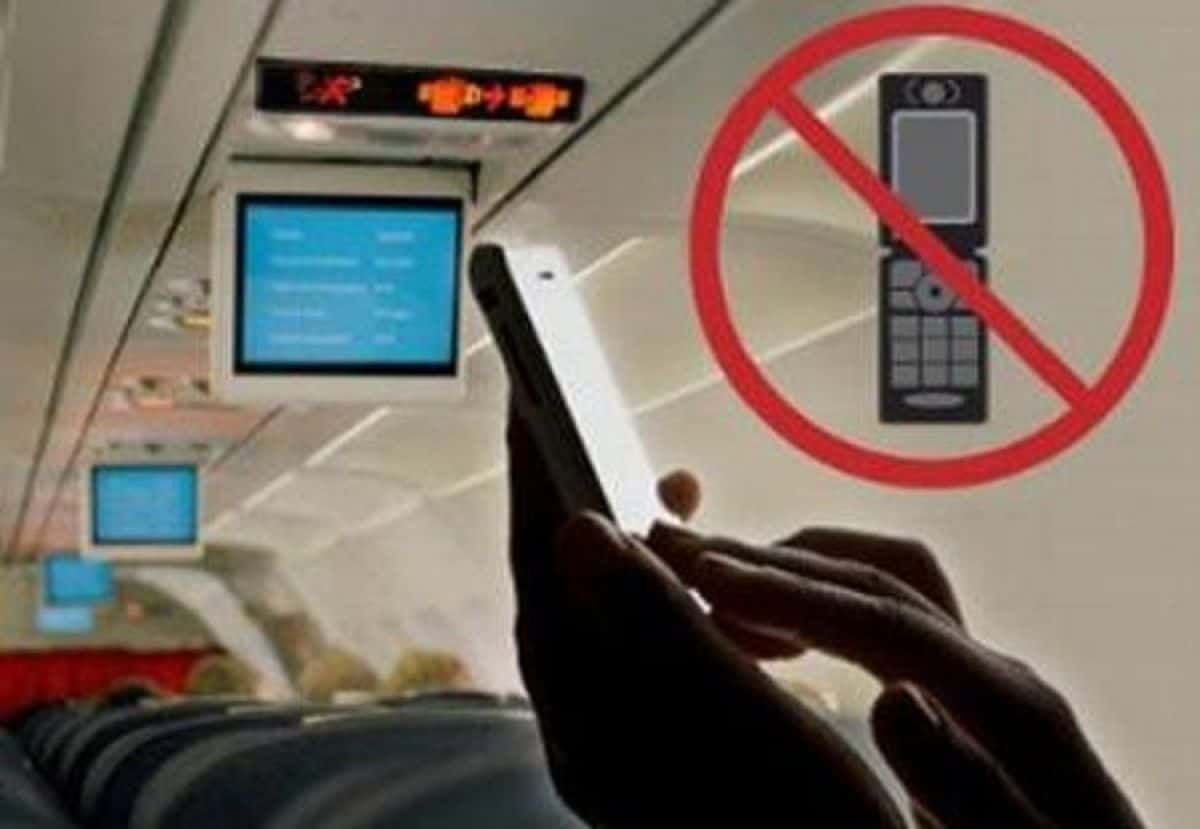
When the plane takes off and lands
During takeoff and landing, you should limit personal activities. Pay attention to stow your tray table, keep your seat upright, stow personal items, and don’t forget to fasten your seatbelt.
Emergency exit signs and emergency exits
When boarding the plane, passengers should note the location of the nearest emergency exit. Usually, emergency exits are located in the passenger cabin. In case of emergency, move quickly to the emergency exit and slide down the slide below.
How to use a life jacket when landing on water
When the plane has to make an emergency landing on water, pay attention to the following instructions for using a life jacket:
On the plane, life jackets are stored in pouches under the seat or in compartments next to the seat. When using, passengers should take them out of the pouch. Then put the jacket over your head, tighten the jacket around your waist. However, you should never inflate the jacket while inside the plane. Only when you reach the emergency exit, you can inflate the jacket by pulling the red tab attached to the jacket or by blowing into the mouthpiece. The life jacket is equipped with both a light and a whistle to attract the attention of others in case of rescue. There are special life jackets for children available on the plane.
9. Traveling by plane with young children
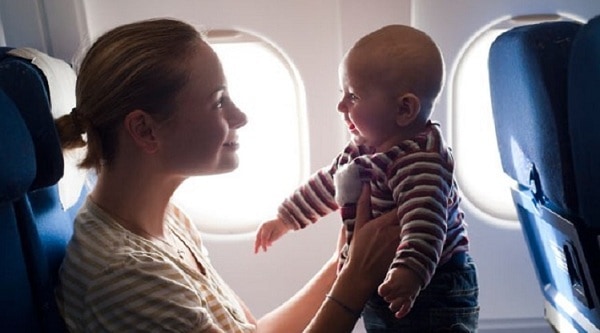
⦁ Bring plenty of essentials
Bring plenty of snacks, milk, toys, and especially diapers, lots of diapers! Even though your luggage may be heavier than usual, they will be very necessary if the flight is delayed, prolonged, or encounters any mishaps. You don’t want to imagine the scene of anxiously waiting and having to hold a crying baby demanding food and diaper change when you have run out of the small quantity you brought along.
Also, bring spare clothes to change immediately for the child and yourself in case the child vomits or spills something.
⦁ Bring a face towel
Not only bring soft tissues and large napkins in case the child vomits, but also bring a face towel. This will be especially useful when the child vomits on the airplane carpet and you have to clean it up yourself.
⦁ Pay for extra legroom
Legroom is almost the most essential thing if you have to hold the child in your lap throughout the flight. The empty space below is convenient for storing bags with diapers, milk, and items needed for the child.
However, consider purchasing an extra seat if the child is over 2 years old and the flight is long.
⦁ Fully charge your electronic devices
You may watch TV or read a newspaper if your phone runs out of battery when flying alone. But when traveling with a child, make sure to fully charge all tech gadgets like phones, tablets, iPads… These are not only essential for you but can also be attractive to the child, making them forget about any discomfort on the plane.
⦁ Arrive early at the security checkpoint
Each airport has different luggage checking procedures. Some places check each bottle of milk or each pack of the child’s food, and may even not allow you to bring them on the plane. Allow extra time and have contingency plans.
⦁ Go straight to the stroller tag area
After passing the luggage check, go straight to the entrance and tag your stroller. Large, non-foldable strollers are often considered as checked baggage, so to avoid trouble, bring a small, foldable one. At this point, let the child play more so they can easily fall asleep when the plane takes off.
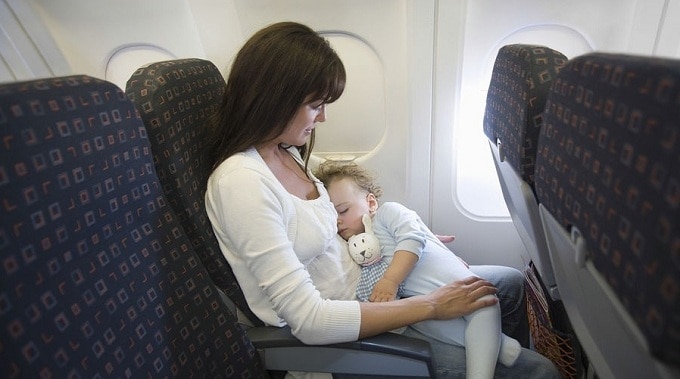
⦁ Bring along toys, candies, and coloring books
Children are often restless or uncomfortable when sitting in a confined space with a seatbelt on. In such situations, unexpectedly giving the child their favorite toy or a large colorful candy will make them forget their discomfort and become happy again. Coloring books for the child to color while flying will also be very helpful.
⦁ Not necessarily board the plane first
After first-class passengers, families are usually allowed to board the plane before the rest of the passengers. This is beneficial for you as it will provide more time to settle the whole family on the flight. However, if the child is too sensitive and anxious, you should not board the plane first and make the child wait among many other people in a confined space. Choose to board the plane first or last depending on the child’s personality.
⦁ Give the child water or milk during takeoff and landing
These times often cause ear discomfort and can make young children frightened. Before takeoff or during landing, give the child milk or water to equalize the pressure in the plane. Even during the flight, if you feel ear discomfort yourself, you should also pay attention to the child.
10. Some health situations when flying
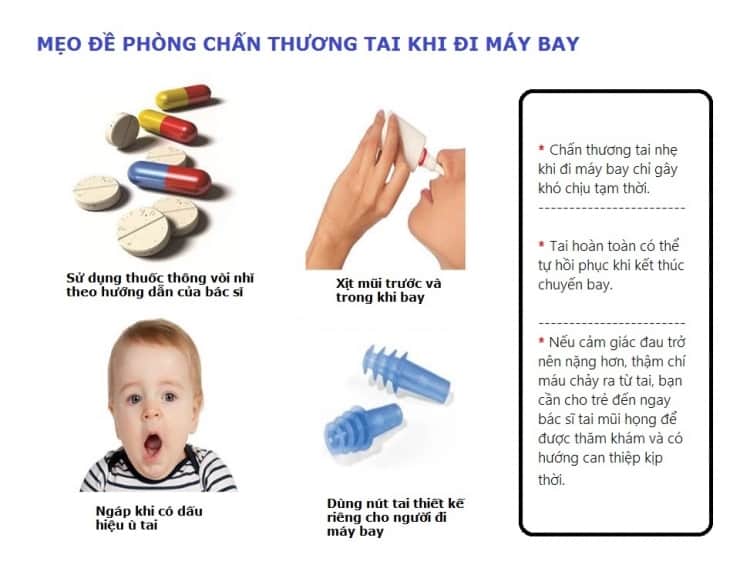
To avoid unfortunate incidents when traveling by plane, besides thoroughly researching the regulations of airlines in the respective countries, it is necessary to know some tips to maintain health during the flight.
⦁ Dehydration
In reality, the cooling system on airplanes increases the risk of dehydration. Moreover, changes in atmospheric pressure and heat disrupt blood circulation. Fatigue from sitting for a long time in the cabin, changes in sleep and eating schedules, lead to disrupted activity rhythms, headaches, insomnia, and bloating.
Therefore, it is advisable to sleep an hour earlier when traveling eastward, and sleep an hour later when traveling westward. Three days before the trip, travelers should consume protein-rich foods like meat, cheese for breakfast, and more vegetables, grains in the afternoon. On the second day, eat light foods like soup, fruits, grilled meat. And on the third day, follow the diet of the first day.
⦁ Ear discomfort
The phenomenon of pressure changes when the plane changes altitude. Some people experience extreme ear pain and earaches at these two times.
To avoid these symptoms, always swallow saliva, yawn, or pinch your nostrils and mouth to balance the pressure inside and outside the ear.
If you have a stuffy nose, use nasal spray or take medication to clear your nose.
Or you can chew gum, chew gum before these two times, and you can avoid ear discomfort.
To avoid these symptoms, always swallow saliva, yawn, or pinch your nostrils and mouth to balance.
To avoid these symptoms, always swallow saliva, yawn, or pinch your nostrils and mouth to balance.
⦁ Swollen feet, muscle cramps
Sitting for too long in a cramped seat that keeps the body almost completely immobile is the cause of swollen feet. This symptom threatens everyone, especially women. This condition becomes more serious for people with circulatory disorders, as it can block the pulmonary veins and cause fatal venous inflammation.
Therefore, stretch your feet for 5 seconds and return to the normal position, repeat this especially for the muscles. Drink plenty of water, a liter of water every five hours. Avoid stimulant drinks like coffee, cola, or alcohol. These drinks increase the risk of dehydration. Avoid sleeping pills or sedatives.
When using these types of medications, you will not be able to move much, and the risk of the mentioned diseases increases. Shake your head from side to side and rotate slowly, do this four times and then change direction, shrug your shoulders and rotate them; raise both hands high, switch from left to right, move your toes and feet up and down several times. If possible, stand up and walk for a while to improve blood circulation.
Slow and deep breathing helps to bring more oxygen into the lungs to supply the blood. Also, to avoid discomfort when sitting on the plane, choose a seat on the wing, avoid sitting in the tail section as it is the most turbulent area. Open the ventilation above your head and direct the airflow towards your face.
Improve blood circulation in the legs: move your toes and feet up and down several times; stand up (if possible), change seats every two hours for a short walk; practice slow and deep breathing; the oxygen level on the plane is lower than in the outside air, so breathing slowly and deeply helps you inhale more oxygen into your lungs to supply the blood.
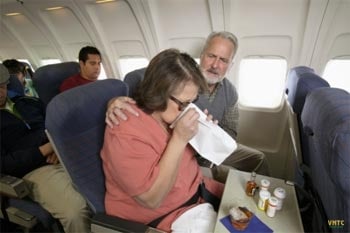
⦁ Some diseases below are not suitable for air travel
According to medical experts, in specific cases, if the disease is diagnosed as stable and all necessary conditions are prepared, and experienced medical staff accompany to ensure the patient’s health safety, air transportation may still be considered acceptable.
However, to avoid risks for the patient and their relatives, special attention and consideration should be given to cases with the following diseases:
- ⦁ People with severe heart diseases in critical stages such as heart failure with symptoms of cyanosis or coronary artery disease or myocardial infarction.
- ⦁ People with serious respiratory system diseases, difficulty breathing or severe bronchial asthma; those with conditions causing air or fluid leakage in the lungs or who have recently undergone medical tests where air bubbles remain in the central nervous system such as brain X-rays with air injection, ventricular brain scans.
- ⦁ People with high blood pressure (above 230/130 mmHg) or low blood pressure (80/50 mmHg).
- ⦁ People with injuries causing symptoms such as coughing up blood, vomiting blood, passing blood in stools.
- ⦁ People who have had a stroke within the last 4 weeks.
- ⦁ People with diseases such as ventricular septal defect, large hernias, intestinal obstruction.
- ⦁ People with brain injuries, skull fractures, or jaw fractures requiring permanent fixation.
- ⦁ People with severe anemia with Hemoglobin levels below 8g/dl.
- ⦁ People who have recently undergone surgery (especially in the chest or abdomen) and have not had enough time for wound healing.
- ⦁ People under the influence of alcohol, drugs, or stimulants.
- ⦁ People with unstable mental conditions that may pose a danger to others.
- ⦁ People paralyzed within 1 month of onset. People with cerebral palsy should not fly at any stage.
- ⦁ People with skin diseases that may be infectious or have peculiar odors.
- ⦁ People with infectious diseases such as cholera, dysentery, typhoid fever, rash, measles, Japanese encephalitis, progressive tuberculosis.
- ⦁ Infants under 14 months old, pregnant women from 32 weeks onwards, women immediately after childbirth.
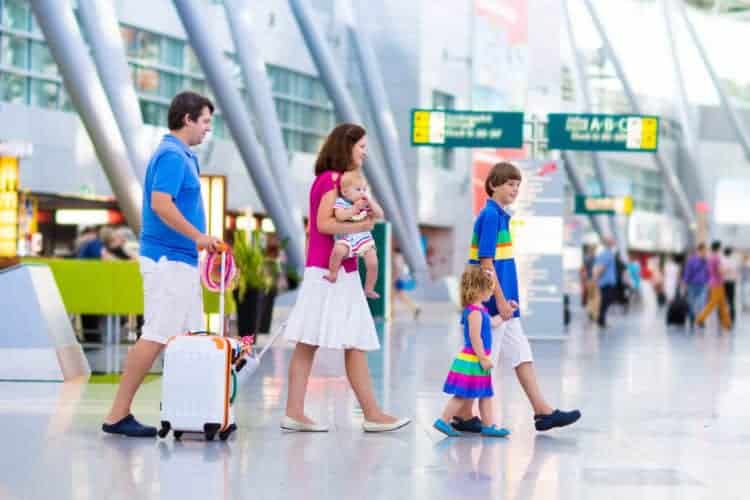
Here is Cuong’s sharing about 10 things you need to know for first-time air travelers. Hopefully, this sharing will be helpful for your upcoming flight with your family. Please continue to like, share, and support the channel to receive more useful travel information! Travel your way and enjoy life your way. Thank you for watching the video.
